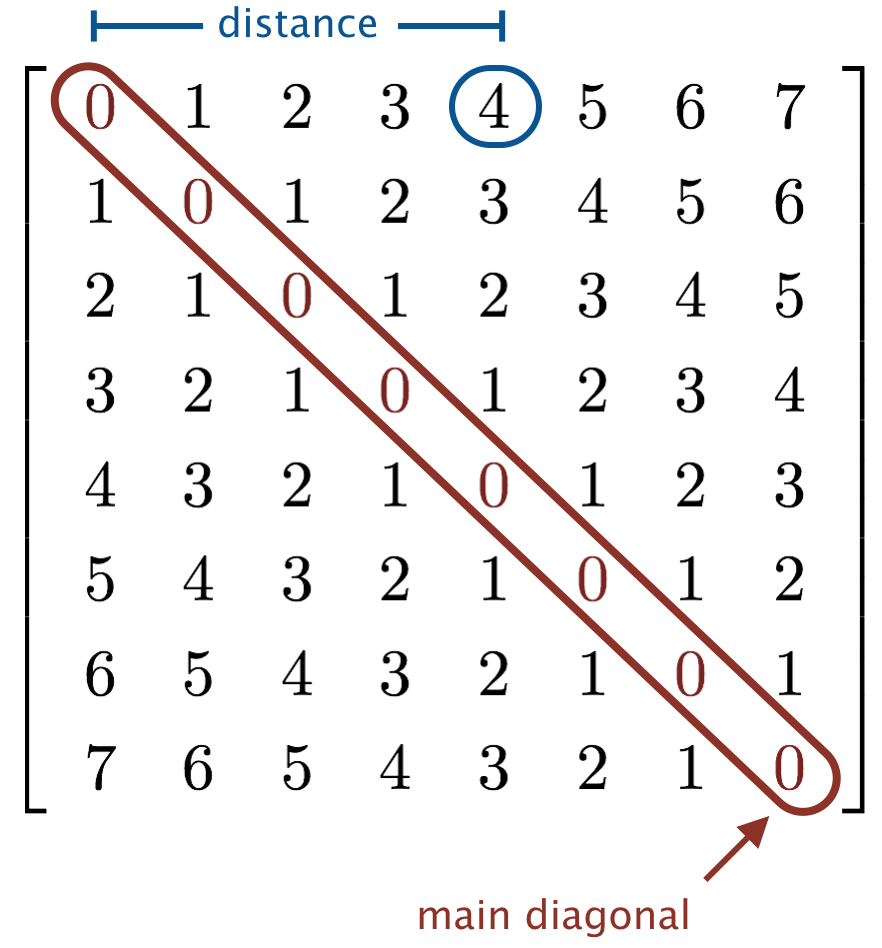 Loops and Conditionals
Loops and Conditionals
The purpose of this assignment is to give you practice writing programs with loops and conditionals.
\( \displaystyle H(n, r) = \frac{1}{1^r} + \frac{1}{2^r} + \cdots + \frac{1}{n^r}.\)For example, \( \displaystyle H(3, 2) = \frac{1}{1^2} + \frac{1}{2^2} + \frac{1}{3^2} = \frac{49}{36} \approx 1.361111\).
~/Desktop/loops> java GeneralizedHarmonic 1 1 1.0 ~/Desktop/loops> java GeneralizedHarmonic 2 1 1.5 ~/Desktop/loops> java GeneralizedHarmonic 3 1 1.8333333333333333 ~/Desktop/loops> java GeneralizedHarmonic 1 2 1.0 ~/Desktop/loops> java GeneralizedHarmonic 2 2 1.25 ~/Desktop/loops> java GeneralizedHarmonic 3 2 1.3611111111111112
Note: you may assume that n is a positive integer.
The generalized harmonic numbers are closely related to the Riemann zeta function, which plays a central role in number theory.
Here, distance means the minimum number of cells you have to move (either left, right, up, or down) to reach any element on the main diagonal.
~/Desktop/loops> java BandMatrix 8 0 * 0 0 0 0 0 0 0 0 * 0 0 0 0 0 0 0 0 * 0 0 0 0 0 0 0 0 * 0 0 0 0 0 0 0 0 * 0 0 0 0 0 0 0 0 * 0 0 0 0 0 0 0 0 * 0 0 0 0 0 0 0 0 * ~/Desktop/loops> java BandMatrix 8 1 * * 0 0 0 0 0 0 * * * 0 0 0 0 0 0 * * * 0 0 0 0 0 0 * * * 0 0 0 0 0 0 * * * 0 0 0 0 0 0 * * * 0 0 0 0 0 0 * * * 0 0 0 0 0 0 * * ~/Desktop/loops> java BandMatrix 8 2 * * * 0 0 0 0 0 * * * * 0 0 0 0 * * * * * 0 0 0 0 * * * * * 0 0 0 0 * * * * * 0 0 0 0 * * * * * 0 0 0 0 * * * * 0 0 0 0 0 * * * ~/Desktop/loops> java BandMatrix 8 3 * * * * 0 0 0 0 * * * * * 0 0 0 * * * * * * 0 0 * * * * * * * 0 0 * * * * * * * 0 0 * * * * * * 0 0 0 * * * * * 0 0 0 0 * * * *
Note: you may assume that n and width are non-negative integer.
Band matrices are matrices whose nonzero entries are restricted to a diagonal band. They arise frequently in numerical linear algebra.
r from the starting point.
How many steps will the random walker take?
This process is known as a two-dimensional random walk.
Write a program RandomWalker.java that takes an integer command-line argument r and simulates the motion of a random walk until the random walker is at Manhattan distance r from the starting point. Print the coordinates at each step of the walk (including the starting and ending points), treating the starting point as (0, 0). Also, print the total number of steps taken.
~/Desktop/loops> java RandomWalker 5 (0, 0) (0, 1) (1, 1) (1, 2) (1, 3) (0, 3) (-1, 3) (-1, 2) (-2, 2) (-2, 1) (-1, 1) (-1, 0) (-2, 0) (-2, -1) (-3, -1) (-3, -2) steps = 15
This process is a discrete version of a natural phenomenon known as Brownian motion. It serves as a scientific model for an astonishing range of physical processes from the dispersion of ink flowing in water, to the formation of polymer chains in chemistry, to cascades of neurons firing in the brain.
r from the starting point.
Print the average number of steps.
~/Desktop/loops> java RandomWalkers 5 1000000 average number of steps = 14.98188 ~/Desktop/loops> java RandomWalkers 5 1000000 average number of steps = 14.93918 ~/Desktop/loops> java RandomWalkers 10 100000 average number of steps = 59.37386 ~/Desktop/loops> java RandomWalkers 20 100000 average number of steps = 235.6288 ~/Desktop/loops> java RandomWalkers 40 100000 average number of steps = 949.14712 ~/Desktop/loops> java RandomWalkers 80 100000 average number of steps = 3775.7152 ~/Desktop/loops> java RandomWalkers 160 100000 average number of steps = 15113.61108
As r increases, we expect the random walker to take more and more steps. But how many more steps? Use RandomWalkers.java to formulate a hypothesis as to how the average number of steps grows as a function of r.
Estimating an unknown quantity by generating random samples and aggregating the results is an example of Monte Carlo simulation—a powerful computational technique that is used widely in statistical physics, computational finance, and computer graphics.
Submission.
Submit a .zip file containing
GeneralizedHarmonic.java,
BandMatrix.java,
RandomWalker.java, and
RandomWalkers.java.
You may not call library functions except those in the java.lang
(such as Integer.parseInt() and Math.sqrt()).
Use only Java features that have already been introduced in the course
(e.g., loops and conditionals, but not arrays).